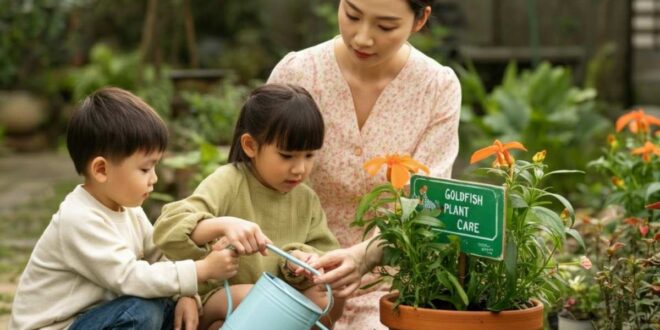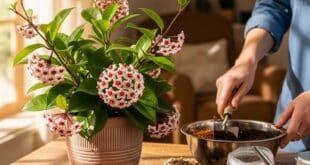Meet The Goldfish Plant
If you’re searching for a unique and rewarding houseplant, look no further than the Goldfish Plant. With its playful, fish-shaped flowers and lush, trailing foliage, this plant is sure to become a star in your indoor garden. Whether you’re an experienced plant enthusiast or a beginner, goldfish plant care is simple when you know what your plant needs. In this complete guide, you’ll learn everything about goldfish plant care—from light and watering to pruning, propagation, and troubleshooting. Let’s dive in and help your “goldfish” thrive!
What Makes the Goldfish Plant So Special?
The Goldfish Plant (scientific names Columnea and Nematanthus) is beloved for its quirky flowers that look just like tiny, plump goldfish. These blooms range in color from bright orange to red and yellow, and they emerge from glossy, dark green leaves that trail beautifully. The plant’s playful appearance and long-lasting flowers make it a favorite for hanging baskets and high shelves.
This plant offers more than just an attractive appearance. With proper care, the goldfish plant can provide you with the following benefits:
- Several months of nonstop flowering, particularly during the spring and summer seasons.
- Rich, trailing greenery that brings a touch of the tropics to any environment.
- Easy propagation for sharing with friends or expanding your collection
- Low maintenance requirements once you understand its basic needs
This plant care isn’t just about keeping your plant alive—it’s about helping it thrive and show off its best features.
Goldfish Plant Origins: Understanding Its Natural Habitat
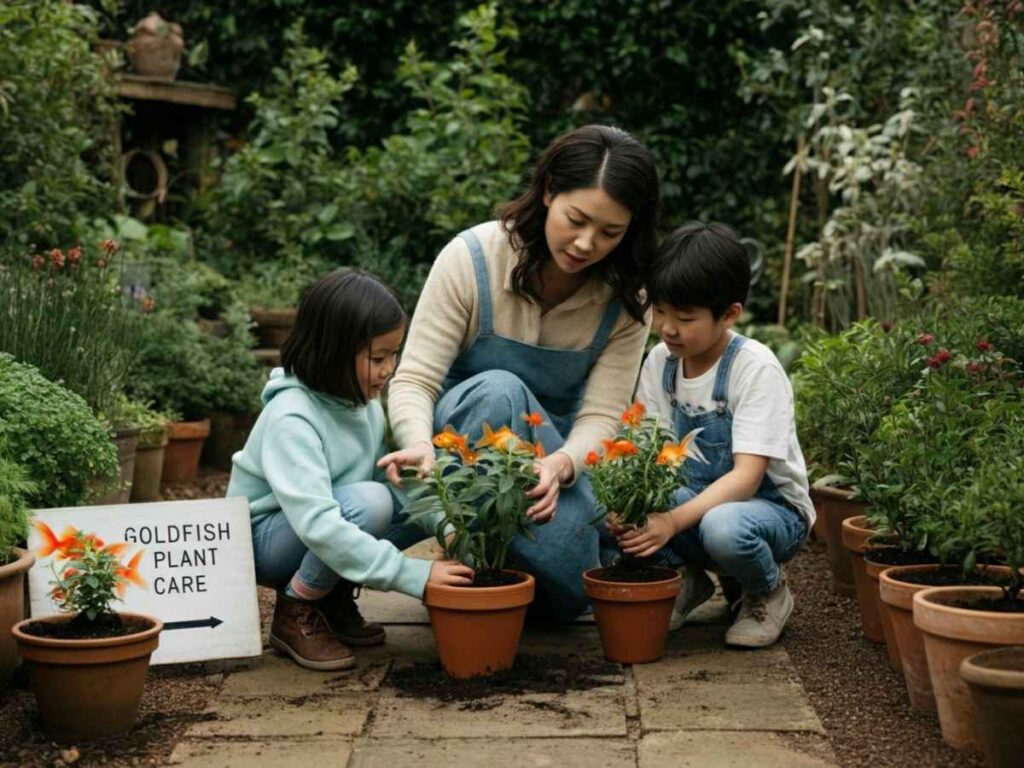
To truly master goldfish plant care, it helps to know where this plant comes from. Goldfish plants are native to the warm, humid rainforests of Central and South America. In their natural habitat, they often grow as epiphytes—plants that live on trees rather than in the ground. This means they’re used to dappled sunlight, plenty of moisture in the air, and well-aerated roots.
By mimicking these conditions at home, you’ll give your goldfish plant the best chance to flourish. Let’s break down the essentials of goldfish plant care, step by step.
Light: The Foundation of Goldfish Plant Care
Why Light Matters
Light is the most important factor for goldfish plant care. Without enough light, your plant won’t produce its signature blooms, and its growth will become leggy and sparse.
How Much Light Does a Goldfish Plant Need?
- Bright, Indirect Light: Goldfish plants need lots of bright, indirect light to flower well. Think of the gentle, filtered sunlight that comes through a rainforest canopy.
- Best Location: Set your plant close to an east-facing window to receive the soft light of the morning sun. If you only have south or west-facing windows, use a sheer curtain to filter the strong afternoon rays.
- Keep Out of Harsh Sunlight: Intense midday sun can burn the leaves, leading to yellowing or brown patches.
- Too Little Light: If your plant isn’t blooming or is growing long, thin stems with few leaves, it probably needs more light.
Light Tips for Goldfish Plant Care
- Turn your plant every couple of weeks to promote balanced and uniform growth.
- If natural light is limited, supplement with a grow light for 10-12 hours daily.
- Remember: More light = more flowers, but never harsh, direct sun.
Watering Wisdom: The Art of Moisture Balance
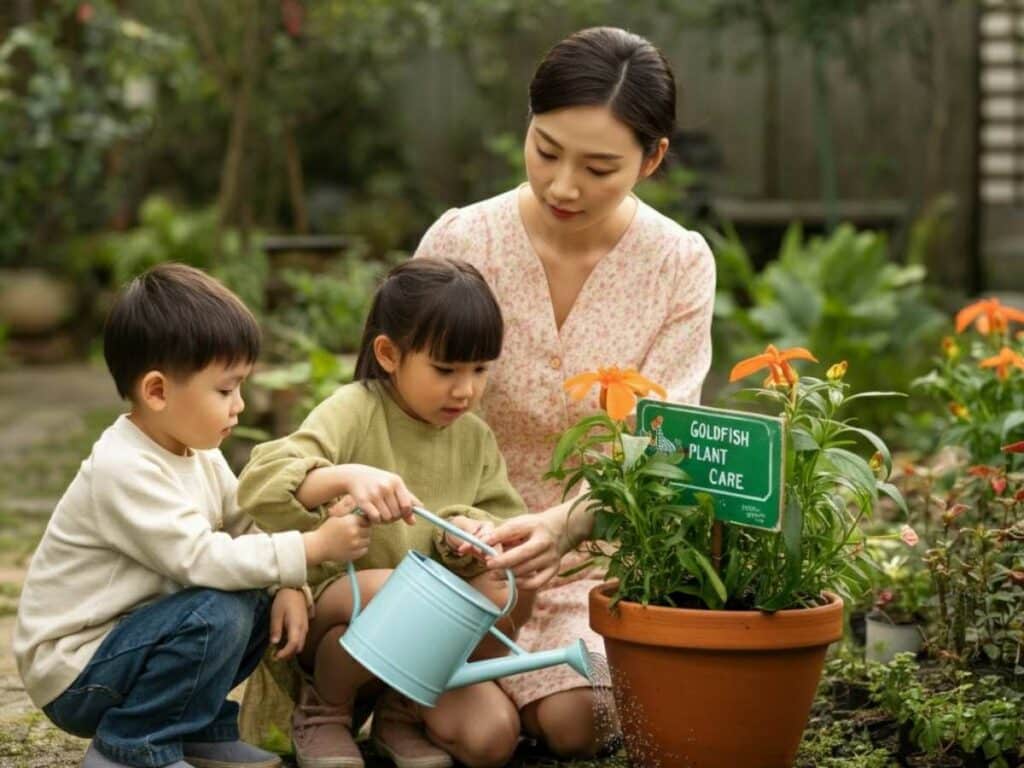
How Often Should You Water?
Watering is a key element of goldfish plant care. These plants like their soil to stay slightly moist, but never soggy.
- Test the Soil: Insert your finger about an inch deep—if it feels dry at that depth, it’s time to water your plant.
- Give a Deep Watering: Water the plant until excess moisture begins to drain from the bottom of the pot. This ensures the entire root ball is moistened.
- Proper Drainage Is Key: Always ensure your plant isn’t left sitting in excess water.Always empty the saucer after watering.
Seasonal Watering Needs
- Spring & Summer: Your goldfish plant will grow and bloom more, so it will need water more often.
- Fall & Winter: Growth slows down, so allow the top 2-3 inches of soil to dry before watering again.
Water Quality
Some goldfish plants are sensitive to chemicals like chlorine and fluoride found in tap water. If you notice brown leaf tips, try watering with filtered water, rainwater, or tap water that’s been left out overnight.
Humidity: The Secret Ingredient for Goldfish Plant Care
Why Humidity Matters
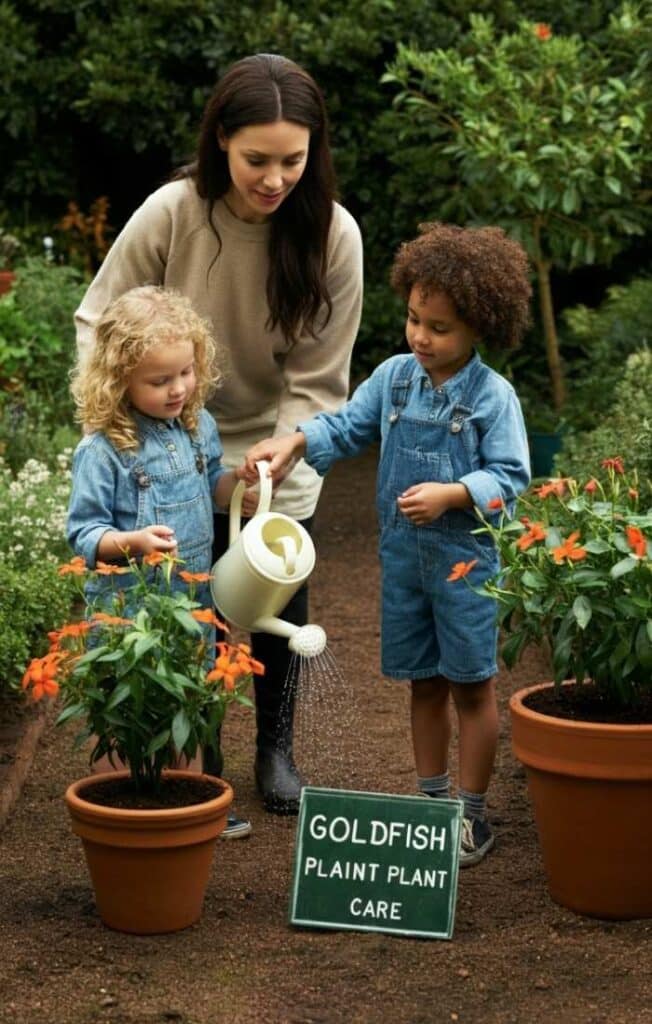
Goldfish plants come from humid jungles, so they love moist air. Dry indoor air, especially in winter, can cause brown leaf edges and dropped buds.
How to Boost Humidity
- Humidifier: The most effective way to raise humidity around your plant.
- Pebble Tray: Place a tray of pebbles and water under your plant’s pot. When the water evaporates, it forms a small pocket of humidity around the plant.
- Grouping Plants: Cluster your goldfish plant with other houseplants to raise humidity naturally.
- Misting: Lightly mist the leaves with room-temperature water, but make sure there’s good air circulation to prevent fungal issues.
Signs Your Plant Needs More Humidity
- Crispy, brown leaf edges
- Flower buds dropping before opening
- Leaves curling or looking dull
By prioritizing humidity in your goldfish plant care routine, you’ll keep your plant looking lush and vibrant.
Temperature: Keeping Your Goldfish Plant Warm and Cozy
Ideal Temperature Range
Goldfish plant care is easiest when you keep your plant in a warm, stable environment.
- Preferred Temperature: 21-27°C (70-80°F)
- Minimum Temperature: Avoid letting it drop below 15°C (60°F) for long periods.
Avoid Sudden Changes
- Protect your plant from cold drafts, open windows, and direct exposure to heat or air conditioning vents.
- Sudden chills or hot, dry air can stress your plant and cause leaves or flower buds to drop.
Soil: The Right Mix for Healthy Roots
Why Soil Matters in Goldfish Plant Care
In nature, goldfish plants often grow on trees, not in dense soil. This means their roots need excellent drainage and plenty of air.
The Best Soil Mix
- Well-Draining & Airy: Use a mix of 2 parts high-quality potting soil, 1 part perlite, and 1 part orchid bark or coco coir.
- Avoid Heavy Soils: Regular garden soil or dense potting mixes hold too much water and can cause root rot.
Repotting Tips
- Replant your goldfish plant every one to two years, preferably during the spring season.
- Select a pot that’s only a bit bigger than the current one and has proper drainage holes.
- Refresh the soil to provide nutrients and prevent compaction.
Fertilizing: Feeding for Flowers
When and How to Fertilize
Proper feeding is an important part of goldfish plant care, especially during the growing season.
- Spring to Early Fall: Feed every 2-4 weeks with a balanced liquid fertilizer for houseplants, diluted to half strength.
- Best Fertilizer: A formula for African violets or flowering plants works well, as it encourages more blooms.
- Winter Rest: Stop fertilizing in fall and winter when the plant is not actively growing.
Avoid Overfeeding
Too much fertilizer can cause salt buildup, leading to root burn and brown leaf tips. Consistent, light feeding is safer than heavy, infrequent doses.
Pruning and Shaping: Encouraging Bushiness and Blooms
Why Prune Your Goldfish Plant?
Regular pruning is essential for goldfish plant care. It keeps your plant looking tidy, encourages bushier growth, and leads to more flowers.
How to Prune
- Pinch Back Tips: Pinch or snip off the growing tips of stems, just above a set of leaves. This stimulates branching.
- Prune After Flowering: Cut back long, leggy vines after a bloom cycle to encourage fresh, vigorous growth.
- Remove Dead or Damaged Stems: This keeps the plant healthy and attractive.
Where Do Flowers Form?
Goldfish plants bloom on new growth. By pruning regularly, you create more new stems—and more places for those charming goldfish flowers to appear!
Propagation: Sharing the Joy
How to Propagate Goldfish Plants
Goldfish plant care includes easy propagation, so you can share this delightful plant with friends or grow new plants for yourself.
Step-by-Step Propagation
- Take a Cutting: Choose a healthy stem 4-6 inches long with several leaves and nodes.
- Get the Cutting Ready: Strip off the lower leaves to reveal one or two nodes.
- Root in Water: Place the cutting in a glass of water, making sure the nodes are submerged but no leaves are underwater. Change the water every few days.
- Root in Soil: Alternatively, plant the cutting directly in moist, well-draining potting mix. Cover with a clear plastic bag to increase humidity.
- Wait for Roots: Roots usually appear in a few weeks. When the roots reach approximately an inch in length, transfer the cutting into its own pot.
Propagating your goldfish plant is both enjoyable and satisfying, offering an easy way to expand your plant collection.
Troubleshooting: Common Goldfish Plant Care Problems
Even with the best goldfish plant care, problems can arise. Here’s how to identify and fix the most common issues:
No Flowers
Causes: Not enough light, too-low temperatures, lack of feeding, or an immature plant.
Solution: Move to a brighter spot, keep temperatures warm, and fertilize during the growing season.
Flower Buds Dropping
Causes: Sudden temperature changes, low humidity, or inconsistent watering.
Solution: Stabilize the environment, boost humidity, and water consistently.
Yellow Leaves
Causes: Overwatering, poorly draining soil, or root rot.
Solution: Allow the soil to dry out more between waterings, ensure proper drainage, and consider repotting if necessary.
Brown, Crispy Leaf Edges
Causes: Low humidity, inconsistent watering, or sensitivity to tap water chemicals.
Solution: Increase humidity, use filtered water, and maintain even moisture.
Drooping Leaves
Causes: Underwatering or overwatering.
Solution: Monitor the soil’s moisture level and modify your watering routine as needed.
Leggy Growth
Causes: Insufficient light or lack of pruning.
Solution: Move to a brighter location and pinch back stems.
Pests
Common Pests: Mealybugs, aphids, and spider mites.
Solution: Wipe off pests with a cotton swab dipped in rubbing alcohol, or use insecticidal soap or neem oil.
Goldfish Plant Care Quick Reference Checklist
- Light: Bright, indirect sunlight is best.
- Water: Water the plant once the top inch of soil feels dry, and always avoid letting it sit in standing water.
- Humidity: Loves high humidity—aim for 50% or more.
- Temperature: Keep warm, between 21-27°C (70-80°F).
- Soil: Use a well-draining, airy mix.
- Fertilizer: Apply a light dose of fertilizer in the spring and summer months.
- Pruning: Pinch regularly for bushiness and more blooms.
- Propagation: Easy from stem cuttings.
Goldfish Plant Care FAQs
How often should I water my goldfish plant?
Water the plant when the top inch of soil is dry to the touch — typically about once a week during warmer months. In winter, water less frequently.
Why are my goldfish plant’s leaves turning yellow?
This often indicates too much watering or inadequate drainage. Allow the soil to dry more between waterings and make sure the pot has proper drainage holes.
Can I grow a goldfish plant outdoors?
Goldfish plants can live outdoors in warm, humid climates with filtered light. In cooler areas, grow them indoors or bring them inside for winter.
What can I do to encourage more blooms on my goldfish plant?
Provide bright, indirect light, feed regularly during the growing season, keep humidity high, and prune to encourage new growth.
Conclusion: Enjoy the Rewards of Goldfish Plant Care
With a little attention and the right goldfish plant care, your plant will reward you with lush, trailing foliage and a spectacular display of goldfish-shaped flowers. Remember to provide bright, indirect light, keep the soil moist but not soggy, boost humidity, and prune regularly. Goldfish plant care is both fun and rewarding, bringing a touch of whimsy and vibrant color into your home. Happy growing—and may your goldfish plant always be full of blooms!

